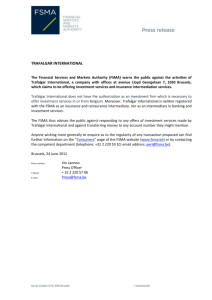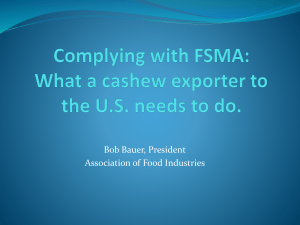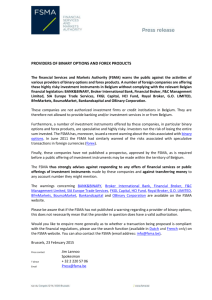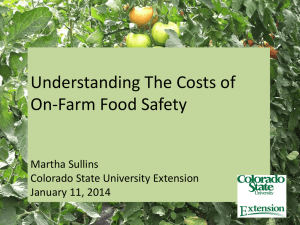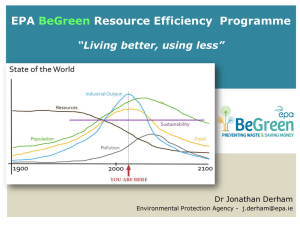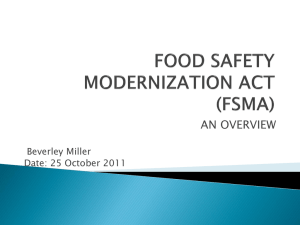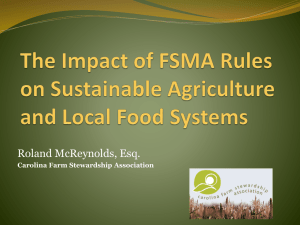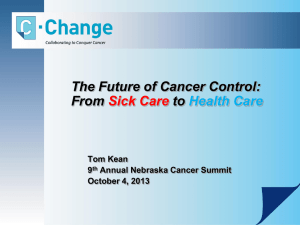here
advertisement
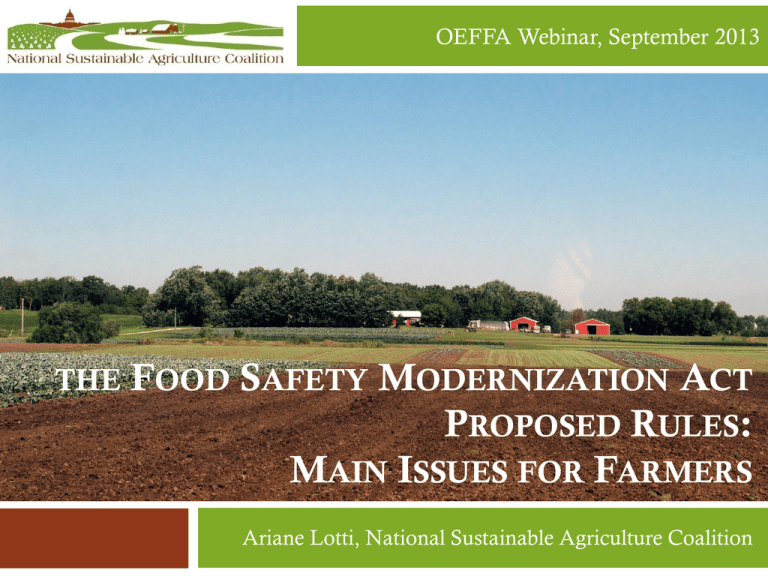
OEFFA Webinar, September 2013 THE FOOD SAFETY MODERNIZATION ACT PROPOSED RULES: MAIN ISSUES FOR FARMERS Ariane Lotti, National Sustainable Agriculture Coalition Who is NSAC? NSAC is an alliance of grassroots organizations that advocates for federal policy reform to advance the sustainability of agriculture, food systems, natural resources, and rural communities. Started in 1988; currently have 100 member organizations from around the country – including OEFFA! We bring farmers and grassroots advocates across the country to the policy table in DC Our job is to make sure that federal policy helps farmers succeed while protecting the environment and keeping our food safe and accessible! Webinar Agenda Brief background and where we are now Produce Rule Issues Preventive Controls Rule Issues Issues in both rules Available resources Approach to Food Safety Everyone has a role in ensuring safe food Focus on highest risk One size does not fit all Based on scientific evidence when possible Overview of Food Safety Modernization Act First major overhaul to food safety laws since the 1930s Debated in Congress in 2009-2010 Signed into law January 4, 2011 Main pieces of the bill: Title I: Preventing food safety problems Standards for Produce Safety Preventive Controls for Facilities Title II: Detecting and responding to food safety problems Title III: Improving safety of imported food Title IV: Miscellaneous provisions Sustainable Agriculture Provisions in FSMA Scale appropriate regulations Protection of on-farm conservation and wildlife practices Complement – not contradict – National Organic Program regulations Minimize extra regulations for low-risk processing that is part of valueadded production Streamline and reduce unnecessary paperwork for farmers and small processors Allow farm identity preserved marketing as an option in place of government trace-back controls Funding for training through new competitive grants program Flexibility for small and very small businesses Where We Are Now PROPOSED regulations for produce safety and food facilities released for public comment on January 4, 2013 Comment period extended twice Deadline for public comment is November 15! Proposed Produce Rule Standards for Growing, Harvesting, Packing, and Holding of Produce for Human Consumption Personnel qualifications and training Health and hygiene Agricultural water Biological soil amendments of animal origin Domesticated and wild animals Growing, harvesting, packing, and holding activities Equipment, tools, buildings, and sanitation Sprouts Proposed Produce Rule Exemptions Produce rarely consumed raw Produce for personal or on-farm consumption Farms selling an annual average value of food during a 3year period that is less than $25,000 Modified Requirements Produce that will receive commercial processing Farms that qualify under Tester-Hagan Amendment Proposed Produce Rule Tester-Hagan Requirements in Produce Standards Average annual monetary value in previous 3-year period less than $500,000 AND Sell 51% or more directly to a consumer or retail food establishment in the same state or within a 275-mile radius THEN Provide information on label or sign at the point of sale Proposed Produce Rule: Issues Manure and compost 9 month interval between application of manure and harvest; 45 day interval between application of compost and harvest Concerns: Discourages the use of manure and compost made with animal material Conflicts with National Organic Program regulations Inconsistent with conservation practice standards Based on very limited scientific evidence Proposed Produce Rule: Issues On-farm natural resource conservation Concerns: Does not explicitly protect or promote conservation practices Does not incorporate co-management considerations Lack of clarity on grazing standards Recently started an Environmental Impact Statement process Proposed Produce Rule: Issues Water and water testing Testing, treatment, regular maintenance and inspection of water system Concerns: Weekly water testing for surface water; monthly for groundwater Testing for generic e. coli (EPA recreational water standard) Water treatment Significant costs and not science-based Proposed Produce Rule: Issues Integrated approach Tentative conclusion to adopt an “integrated” vs. “commodityspecific” approach Support: Important for diversified farmers Commodity organizations prefer commodity-by-commodity approach Proposed Preventive Controls Rule Focuses on facilities that manufacture and process food for human consumption Two major requirements: Hazard Analysis and Risk-Based Preventive Controls (HARPC) Updated Good Manufacturing Practices Codifies “farm mix-type facility” – an operation subject to the Produce Rule AND the Preventive Controls Rule Proposed Preventive Controls Rule Exemptions from HARPC requirements Certain on-farm low-risk processing activities (jams, maple syrup) by small and very small businesses Seafood, juice, low acid canned foods, dietary supplements, alcoholic beverages Activities within the ‘farm’ definition Certain facilities that only store packaged foods or raw agricultural commodities (not F&V) for further processing Proposed Preventive Controls Rule Modified Requirements Facilities that qualify under Tester-Hagan Amendment: “Very small business” OR Average annual monetary value in previous 3-year period less than $500,000 AND Sell 51% or more directly to a consumer or retail food establishment in the same state or within a 275-mile radius that sells food directly to consumers Proposed Preventive Controls Rule Modified Requirements Submit documentation of status AND Submit documentation of compliance with other nonFederal food safety law AND provide notification to consumers OR Submit documentation identifying potential hazards and monitoring or preventive controls Proposed Preventive Controls Rule: Issues Failure to clarify exemption for direct marketers Under FSMA, CSAs, roadside stands, farmers markets, and other directto-consumer sale platforms are considered “retail food establishments” that do NOT have to register as a facility with FDA Concern: FDA has not clarified this exemption from the Preventive Controls Rule and certain CSAs and direct marketers will be subject to additional inappropriate regulation if they trigger the “facility” definition Proposed Preventive Controls Rule: Issues Options for definition of “very small business”: $250,000 in gross sales of all food $500,000 in gross sales of all food $1,000,000 in gross sales of all food Concerns: “All food” not “covered product” If not realistic, small facilities regulated like big facilities Issues in Both Proposed Rules What is a “farm”? What is a “facility”? Concerns: Confusion around foundational definitions like “farm” and “facility” Assumption that farms only produce raw agricultural commodities and don’t prepare and sell food through markets and supply chains When you pack or hold someone else’s agricultural products, you are a “facility” Introduce new term, “farm mixed-type facilities,” subject to both rules Issues in Both Proposed Rules Failure to adequately implement scale- and supply-chain appropriate options Concerns: Failure to clarify key terms Failure to require an evidentiary standard for withdrawal Failure to establish a reasonable process around withdrawal and restitution of status Issues in Both Proposed Rules Costs of compliance High costs without adequate training and technical assistance Produce rule: “Very small” farm: $4,697 annually “Small” farm: $12,972 annually “Large” farm: $30,566 annually Preventive Controls: $13,000 per year to comply with HARPC Concerns: Risk of farms going out of business Increased barriers for beginning farmers Further concentration in farming Available Resources NSAC Website: http://sustainableagriculture.net/fsma Background Issue Pages How to Comment Additional Resources Campaign Materials: FSMA website Website sections: FSMA Website Produce Rule Overview FSMA Website Preventive Controls Rule Overview FSMA Website “Am I affected?” guidance (Including specific guidance for food hubs, CSAs, and direct marketers) FSMA Website Issue overview pages FSMA Website Issue overview pages contain: Background What the rules do and don’t require Direct links to the relevant rule text Questions to guide comments to FDA about the issue Additional resources FSMA Website Step by step instructions on how to comment Questions? Email: alotti@sustainableagriculture.net Get involved and more information: http://sustainableagriculture.net/fsma Join OEFFA for a webinar on October 28 at 6pm to learn about the commenting process and how to advocate for food safety regulations that support sustainable agriculture. Email mackenzie@oeffa.org for details on registration.
